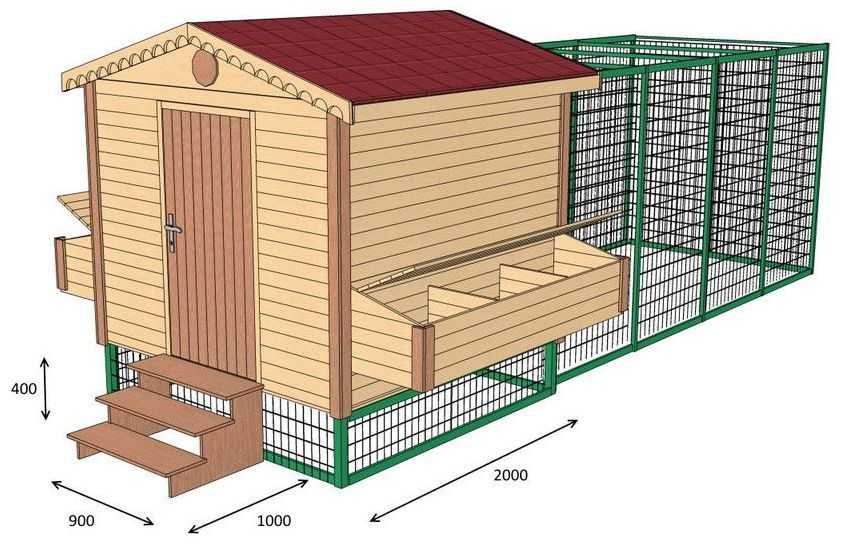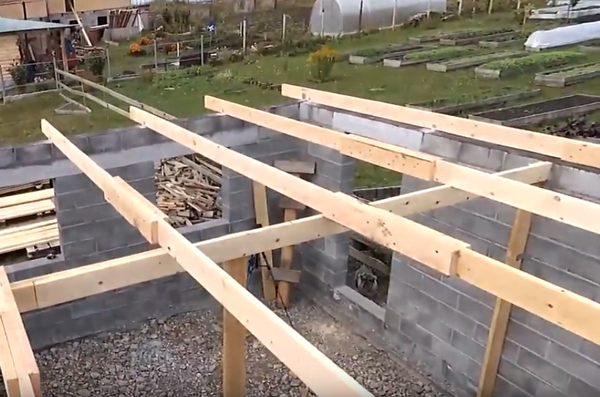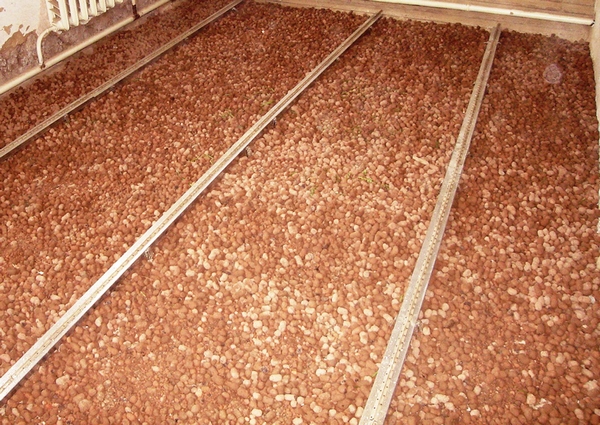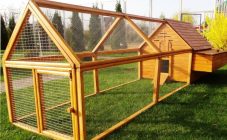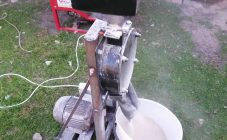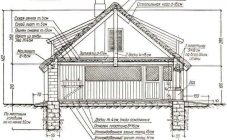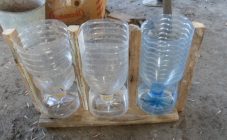Content:
Improper care of chickens and chickens in winter in cold weather can have the most undesirable consequences. In order to avoid a fatal mistake, you should study the basic rules for caring for a bird in winter and organize a warm comfortable chicken coop for them.
Chicken and Chick Care
In order for chickens and chickens to survive the cold, they should be provided with the proper conditions:
- the chicken coop should be warm and light;
- there must be good ventilation in the hen house, while it is necessary to ensure that there are no drafts at all;
- to improve the air in the winter period, periodic juniper fumigation is carried out in the hen house; vapors of this herb are useful to inhale not only for birds, but also for people;
- peat mats should be laid on the floor - this will keep the floor dry, and droppings can be removed once a week directly with the top layer;
Since the chicken is not the most winter-hardy bird, in addition to the insulated chicken coop, it should be provided with a special diet for the winter.
In this regard, it is recommended to hang brooms from dried herbs: nettle, clover and alfalfa in the corral. They will provide the birds and their young with the necessary amount of vitamins. Chopped vegetables should be added to the feed. Carrots or pumpkin are best suited for this purpose. Periodically, chickens should be fed meat or fish waste. As for the grain, it needs to be crushed and steamed.
Mixtures should be prepared taking into account the recommendations of professional livestock specialists. Unfortunately, not all poultry houses are able to adhere to all the rules for winter feeding of chickens, which results in their low productivity. If the conditions are really bad, the hen simply stops laying eggs.
How to make a chicken coop with your own hands
Practice shows that housekeeping is a great help. 10-15 chickens will provide eggs and meat for a large family. But before buying chickens, you should build a warm chicken coop in which the bird will feel comfortable both in winter and summer.
There is no big difference between such a structure as a hen house for 15 hens and a hen house for 20 hens. Their construction is about the same. Therefore, consider the construction of a do-it-yourself chicken coop for 20 chickens.
Calculation of parameters
The size of the hen house is calculated taking into account the number of birds that will live in it. In cramped conditions, the hen will feel uncomfortable and produce fewer eggs. It is usually believed that 2 to 4 chickens can safely fit on 1 square meter. They are not very mobile, and this place is enough for them. Thus, for 15-20 chickens, 7-10 squares will be enough. Most often, they try to make the structure square - so it is easier to maintain.
Next, you should decide on what height the chicken coop will be with your own hands for 20 winter chickens.Usually, the roof is made slightly taller than a person's height so that you can move in it without bending over.
Material selection
When the layout is determined and the size of the building is selected, it is time to select the material. A cheap chicken coop made of plywood or OSB is only suitable if the birds are planned to be kept in it only in the summer. If the plan includes equipping an all-season paddock, the frame option disappears (unless, of course, there is a desire to spend a lot of money on insulation), for a warm shelter for chickens, the following materials are more suitable:
- timber;
- log;
- cinder block;
- foam concrete;
- sandstone, etc.
Such a building is usually insulated with the simplest and most inexpensive materials: foam or mineral wool. The latter is more preferable because it is vapor permeable and allows you to effortlessly maintain a normal indoor humidity index.
Project preparation
Regardless of the selected type of poultry house for fifteen to twenty birds and the material from which it will be built, a project for a chicken coop for 20 chickens in the winter version and drawings will be required. They should be as detailed as possible and contain all details and dimensions. A similar drawing may look like this:
A drawing and a detailed diagram add clarity and allow you to more accurately calculate how much materials a finished chicken coop will require.
Building a chicken coop: step by step instructions
Laying the foundation
The construction of any structure begins with laying the foundation. A self-contained poultry house is no exception to the rule. Depending on financial capabilities, the farmer can choose between the following popular types:
- tape;
- columnar type.
The tape-type foundation is quite expensive, since it involves pouring around the perimeter with concrete. It is advisable to use it for the construction of a chicken coop only if the finished hen house will stand on unstable soil. A columnar foundation is somewhat cheaper than a strip foundation. It is quite easy to perform and practical. To build it you will need:
- Carry out a markup of the place.
- Place 4 pegs in all corners of the building.
- Remove the surface layer from the soil.
- Mark the locations of the pillars for the future foundation.
- Dig holes.
- Install the posts directly into the pits.
- Fasten the structure with cement.
- Wait until the cement mortar is completely dry.
- Apply bitumen or other protective coating to the posts.
- Fill up the space between the posts and the ground with rubble.
- Place the lower support beams, fastening them at the corners.
To lay an even base, it is necessary immediately after the installation of the posts, but before the final hardening of the fastening compound, stretch the rope between them and make sure they are parallel to the ground using a level.
Construction of walls and roof
Having finished with the base, it's time to proceed to the walls, and then the roof. If you choose wood as the material, the first thing to do on 4 sides is to install load-bearing beams from a bar, the cross-section of which is at least 150 mm. They are attached directly to the joists at an angle of 45 degrees in relation to the floor and walls. Then the frame beams are connected from above with frame beams and fixed. Then the outer part of the hen house is sheathed with boards, with the obligatory consideration of predetermined places for ventilation, doors and windows.Upon completion of the sheathing, the boards are treated with linseed oil and sealant. Then they start roofing work. For the roof, ceiling joists are placed on the upper supporting beams. The distance between them should not be less than 1 meter.
For lags, a bar with a section of 150x100 mm is suitable. After laying, the logs must be covered with boards, as well as any roll insulation. It is better to make a gable roof. The detailed construction process for such a roof can be described as follows:
- Place vertical beams in the center of the short side of the house.
- Attach rafter holders to them at angles of 50 and 35 degrees, respectively.
- Place the rafters on the holders on each side of the house.
- Cover the roof with corrugated board or other material.
Warming
Warming is done before the interior decoration of the house. A space of 15 cm (corresponding to the thickness of the support bar) is filled with mineral wool, polystyrene or foam rubber. Additionally, it is allowed to cover the insulation with dense foil for better heat accumulation inside. After laying the insulation layer, it remains to sheathe the house with boards from the inside.
Floor laying
Laying floor lags is done in the same way as overhead lags. It is only better to use a square beam with a section of 150 mm. It is recommended to lay an airtight coating between the logs before insulation. Then comes the turn of the boards. They are attached to the logs with long nails. Self-tapping screws can be used. All cracks are coated with a chicken-safe sealing compound.
Internal arrangement
After the completion of construction work, all that remains is to equip the interior space. You will need to mount and install:
- nests;
- roosts;
- feeder;
- drinker;
- container with sifted ash;
- heater;
- ventilation system;
- lighting.
All elements inside the room should be installed so that they do not interfere with the approach to the nests for the purpose of cleaning them. It is recommended to make perches from a round bar with a section of 25 mm.
The bottom of the chicken coop should be covered with straw or sawdust in a layer of 5 cm. Sifted ash is required for chickens for bathing, and with its help they get rid of parasites.
It is more expedient to place the nests in the far part of the chicken coop. This will provide the birds with relative peace.
Do not forget that during the winter period the birds should be provided with walking. Alternatively, you can make an extension to the chicken coop, or simply place it on the site in a place where chickens can walk normally in relatively warm weather.
Tips from experienced poultry farmers
Experienced poultry farmers offer the following ways to increase the egg production parameter of chickens in winter:
- The temperature rises in the hen house. Of course, you should not arrange a sauna for the birds, but if the temperature is not lower than +15 degrees, egg production will increase by at least 40%.
- If you artificially increase daylight hours, productivity can be increased by 10-15%. But don't be too zealous. If you "organize" daylight hours for more than 14 hours, birds may stop laying eggs altogether.
- If you feed the birds with greens, they will rush more.
- Reducing the units of individuals per unit area can also contribute to an increase in egg production.
It may seem to novice poultry farmers that keeping chickens is not difficult. But before deciding on this step, you should thoroughly prepare. After all, a positive result will be only if the chickens are completely comfortable.
